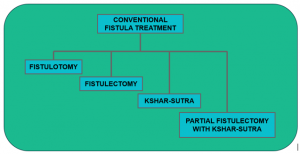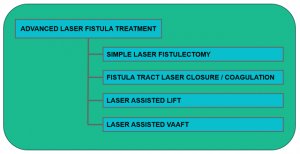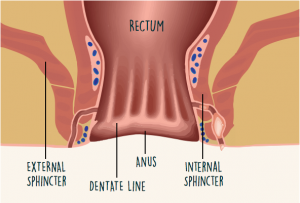 Fistula Treatment in Latur | Fistula Surgery In Latur |Laser treatment of Fistula | Fistula Laser Treatment
Fistula Treatment in Latur | Fistula Surgery In Latur |Laser treatment of Fistula | Fistula Laser Treatment
A fistula is an abnormal connection between an organ and another structure. The most common location for a fistula is around the anus, called anal fistulas. An anal fistula is a tunnel that runs from inside the anus to somewhere in the perianal skin. It usually follows perianal infection (such as hair root infection, boil or abscess) that didn’t heal the right way.
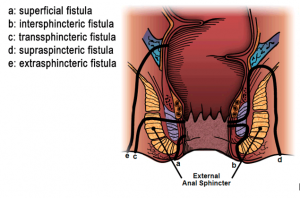 The second most common location is between two loops of intestine. Fistulas can also form between the:
The second most common location is between two loops of intestine. Fistulas can also form between the:
- Rectum and vagina
- Intestine and skin
- Intestine and bladder
Perianal fistulas are subclassified by their location and complexity (Figure 1). Anatomically there are two sphincters (internal and external), which are muscles that enable you to control bowel movements.
Fistulas can form across 1 or both sphincters (Figure 2). They also can form above or between the sphincters. Some fistulas start high up in the rectum and do not cross the sphincters at all. Fistulas can be simple (single tunnel) or complex (multiple tunnels).
If the fistula is located in the lower anal region and is subcutaneous or submucous in nature, it is classified as a low-level fistula. However, if it affects the higher anal or the pelvic-rectal region, it is considered as a high-level fistula. Depending on its effects on the sphincter muscles, a fistula is further classified as intersphincteric, transphincteric, suprasphincteric or extrasphincteric.
Causes of Anal Fistula
The most fistula is a sequel of a previous abscess or pus cavity. The pus formation is the result of an anal gland infection. When this abscess fails to heal completely, with or without treatment, a fistula develops.
Some diseases can also cause Fistula including:
- Inflammatory bowel diseases such as ulcerative colitis, Chron’s disease
- Cancer
- Tuberculosis
- HIV and other sexually transmitted diseases
- Diverticulitis
- Traumatic injury
Symptoms of Anal Fistula
Patients with fistulas commonly have a history of an untreated or previously drained anal abscess. Common symptoms of anal fistula are:
- Anorectal pain
- Discharge from perianal skin or anus
- Irritation or itching of perianal skin
- Anorectal swelling/boil
- Perianal cellulitis (redness of the skin)
- Occasional rectal bleeding
Symptoms of a fistula depend on where the connection has formed. Fluid or waste may leak continually from the anus or vagina. A fistula between the intestine and bladder can cause a urinary tract infection that keeps returning. Fistulas between two loops of the intestine may not cause any symptoms.
Diagnosis of Anal Fistula
A careful history regarding anorectal symptoms and past medical history is necessary, followed by the rectal examination. When diagnosing an anal fistula, an external opening that drains pus, blood or stool is usually seen on examination. Heaped up tissue at the external opening suggests a well-established fistula. A digital rectal exam may produce pus from the external opening. Some fistulas will close spontaneously, and the drainage may be intermittent, making them hard to identify at the time of the office visit.
Use of Diagnostic Studies:
- Fistulography, an X-Ray of the fistula after injecting a contrast solution.
- MRI Fistulogram may be needed for complicated fistulas in which the track is difficult to delineate.
- Endoanal Ultrasound
- Colonoscopy to rule out inflammatory bowel diseases in recurrent and multiple fistulae.
Treatment of Anal Fistula
Currently, there is no medical treatment available for this problem and surgery is almost always necessary to cure an anal fistula.
An anal fistula is a condition that demands respect and prompt accurate treatment by specialized surgeons who deals with these conditions frequently, it is best done at specialized proctology centers like Nirmal Anorectal and Multispecialty Hospital which provide the best Fistula Surgery In Latur. The main reason is the difficulty in approaching this abnormal tunnel and destroying it without injuring the anal sphincter muscle (this is the circular muscle surrounding the anal canal and through which most anal fistula pass.)
It is a fact that a significant injury to anal sphincter muscle will cause life-long incontinence and loss of control over the anal canal content release… This loss of control is a serious complication that unfortunately we see too often after an overzealous fistula surgery done by non-specialized centers.
There are different ways to treat a fistula with surgery. These include conventional and advanced Laser-assisted surgical procedures.Dr. Sachin Pandhare provides the best Laser treatment of Fistula.
1. Conventional Surgical Procedures
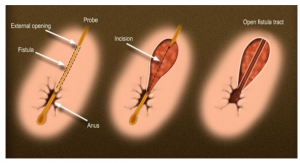 A. Fistulotomy
A. Fistulotomy
Low-level fistulas are commonly treated using a fistulotomy. The surgeon opens the tunnel surgically so that it can heal cleanly on its own. For simple fistulas near the skin surface, this procedure is very successful. This procedure is not ideal for fistulas that cross the sphincters.
Ksharsutra for Fistula is one of the successful Ayurveda treatment methods with a high success rate. Our Consulting Proctologist, Dr. Sachin Pandhare has treated a larger number of fistula cases using Kasharsutra procedure. Ksharsutra treatment is a safe method for Anal Fistula and other sinus diseases. In this technique, a specially medicated thread is used.
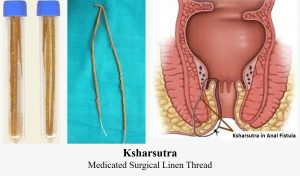 Procedure
Procedure
Ksharsutra for fistula is first prepared by coating a surgical linen thread gauge number 20 with Snuhi latex (Euphorbia nerifolia) for 11 times. Snuhi latex and Apamarga Kshara for 7 times and Snuhi latex and Haridra churna for 3 times.
The patient must be with local or spinal or general anesthesia while treatment. Then a malleable probe passes through the external opening of the fistula to the internal opening in the anal canal. And probe is gently taken outside along with a Ksharsutra in the groove of the probe.
Later both ends of the Ksharasutra is joint together and replaces with a new one a week later. The Ksharasutra gradually cuts and heals the track. Finally, the whole fistulous tract heals after cutting.
Benefits of Ksharsutra
- No hospital stays
- Routine works unaffected
- Minimal pain
- Usually performed under local anesthesia
- Effective results
- No risk of incontinence
- Suitable for multiple Fistula-in-Ano
- No dressing required
- Widely accepted and Clinically proven
- Recurrence rate is low
Mode of Action
- It helps in Cutting of the tract draining of the pus, curetting of unhealthy tissues. And healing of fistula occurs simultaneously as well.
- Due to the caustic action, it removes the unhealthy tissue thus promotes healing
- Controls infection by the microbicidal action.
- Laying the track open by cutting through the tissues.
One might experience mild post-procedural pain after the treatment. And this method requires multiple sessions.
Surgeons recommend “Ksharsutra” to treat Anal Fistula because it is highly safe as well as highly effective and also helps in quick recovery.
D. Partial Fistulectomy With Ksharsutra
In this procedure probing is done from external opening and the internal opening is revealed at the anal canal. The excision of the fistulous tract by coring method is done from external opening till external anal sphincter with the help of electric cautery. After that Ksharasutra is applied in the remaining part of the tract.
2. Advanced Laser Fistula Treatment in Latur
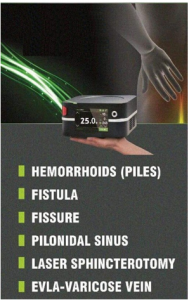 A. Simple Laser Fistulectomy
A. Simple Laser Fistulectomy
Fortunately, 85% of anal fistula cases are below the sphincter muscle and therefore require simple laser Fistulectomy which we do at Nirmal Anorectal and Multispecialty Hospital under anesthesia. Laser wounds heal fast and in near painless fashion and do not interfere with the patient’s daily activities at all.
B. Fistula Tract Laser Closure / Coagulation
A radially emitting Fistula Laser Fiber is inserted from the external opening till internal opening. A defined amount of laser energy is then emitted circumferentially into the fistula tract. The laser energy causes controlled photothermal destruction of the fistula tract causing it to collapse to a high degree. This also helps supports and accelerates the healing process. This painless laser procedure is done under anesthesia. The aim of the procedure is to gently remove the fistula tract without damaging the sphincter muscle.
C. Laser Assisted Lift (Ligation of Intersphincteric Fistula Tract)
The intersphincteric tract is identified and isolated by performing meticulous dissection through the intersphincteric plane after making a small incision overlying the probe connecting the external and internal openings. Once isolated, the intersphincteric tract is hooked with a small right-angle clamp, and the tract is ligated close to the internal sphincter and then divided distal to the point of ligation. Hydrogen peroxide is injected through the external opening to confirm the division of the correct track. The external opening and the remnant fistulous tract are curetted to the level of the proximity of the external sphincter complex. Finally, the curetted wound is coagulated with the laser technique. Nirmal Hospital provides the best Fistula laser Treatment
D. Laser Assisted VAAFT(Video Assisted Anal Fistula Treatment)
Here, we take great advantage of our Endolaser tools to cure high fistula with one or two-stage procedure that respects the sphincter muscle and keep it intact at all times, we use the Fistuloscope (a little cannula with a camera at the tip) and the advanced Laser assisted VAAFT procedure (LA-VAAFT) when adequate, as well as more technically delicate procedures to cure the fistula of the first go.
3. Fecal Diversion / Colostomy
If the above discussed surgical options do not work, this procedure is done to re-route digestive waste. The healthy end of the large intestine is attached to a surgical opening in the skin. Digestive waste is eliminated through the small opening called a stoma. This procedure can be temporary or permanent.
“We are the referral center of many surgeons and physicians for Anal Fistula.”
After your treatment, the nurse will go over a few instructions and you will be given a prescription for a few medications and an appointment for a postoperative checkup a few days later.


